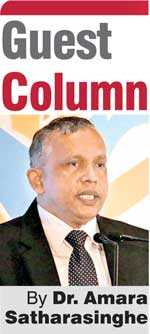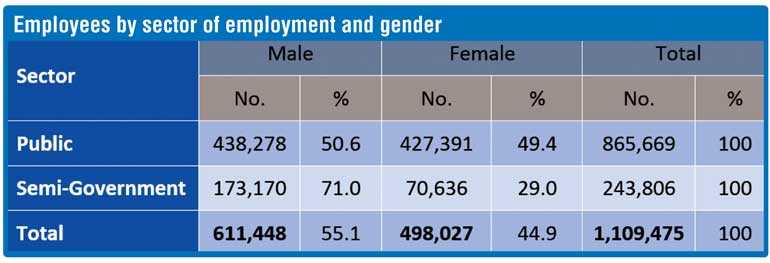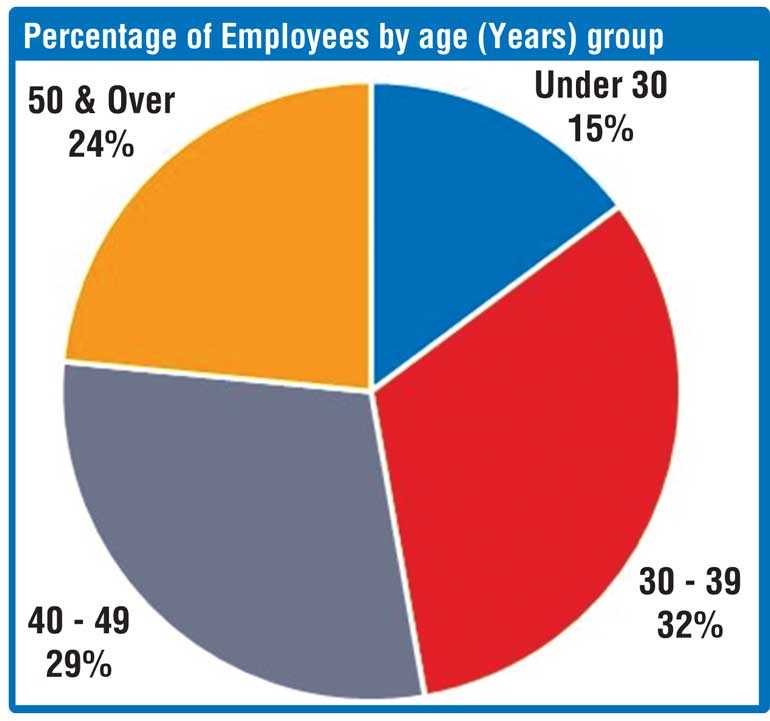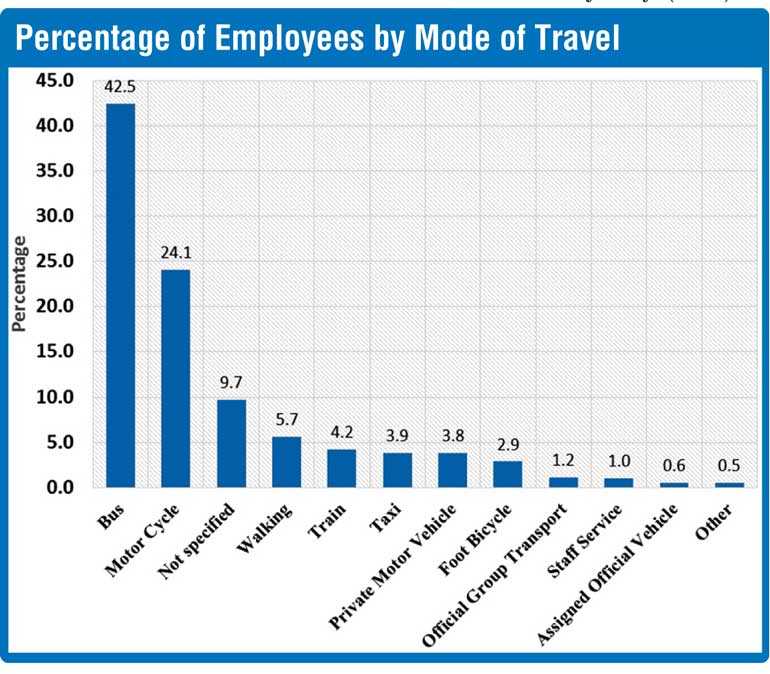Monday Dec 08, 2025
Monday Dec 08, 2025
Tuesday, 10 July 2018 00:00 - - {{hitsCtrl.values.hits}}

People waiting for a train at Maradana Railway Station. The total number of employees in the Public and Semi-Government sectors excluding uniformed staff of the three forces – Army, Navy and Air Force – as at 17 November 2016 was enumerated as 1,109,475 – Pic by Shehan Gunasekara
The importance of the Public Sector is an indisputable social and economic reality throughout the world. The Public Sector usually comprises of organisations that are owned and operated by the Government and exist to provide services such as public education, healthcare, national defence, military, police, infrastructure (public roads, bridges, tunnels, water supply, sewers, electrical grids, telecommunications, etc.) for its citizens. 
Recognising the importance of the Public and Semi-Government Sector employment statistics, the Department of Census and Statistics (DCS) has conducted periodic Censuses of Public and Semi Government Sector Employment. The first such Census was taken in 1980. Subsequently, censuses were carried out in 1985, 1990, 1994, 1998, 2002 and 2006 at intervals of four to five years. Since the devolution of power to Provincial Councils in 1987, employment censuses from 1990 onwards covered both the Central Government and Provincial Councils.
The latest round of the Census of Public and Semi Government Sector Employment was conducted by the DCS between 9:30 a.m. and 11:30 a.m. on 17 November 2016 and it is the eighth in the series of such censuses. The findings presented here, are based on data gathered through questionnaires personally completed by more than one million employees in these two sectors. This census did not cover the uniformed staff of the three forces: Army, Navy and Air Force.
The information collected at this census include sector of employment, age and sex, marital status, nature of appointment, level of education, major occupation group, professional/ vocational qualifications, language skills, district of the place of work, mode of travel to work, non- communicable diseases, level of ICT literacy, etc. of the employees. Key findings of this census are presented here.
Number and proportion of employees
The total number of employees in the Public and Semi-Government sectors excluding uniformed staff of the three forces – Army, Navy and Air Force – as at 17 November 2016 was enumerated as 1,109,475. Of the total employees, 55.1% are males; 44.9% are females. In any employment census, it is usual to determine the employees as a percentage of the total population and as a percentage of employees of all sectors (including all other sectors). Total number of employees is estimated quarterly as well as annually through Sri Lanka Labour Force Survey conducted by the DCS.
Public and Semi-Government Sector employees constitute 5% of the population in the country. The proportion is the same across provinces, with the exception of North Central and Uva Provinces where it is 6% and the Western Province where it is 4%.
As a proportion of all employees i.e. in all sectors, Public and Semi-Government employees are 14%. This proportion is highest (18%) in the Eastern Province and lowest (11%) in North Western and Sabaragamuwa Provinces.

Sector of employment
The census covered 32,750 institutions of which the majority belong to the Central Government. The majority of institutions coming under Provincial Councils comprises schools and hospitals functioning under the nine Provincial Councils.
The majority of employees (65.3%) are attached to institutions coming under the Central Government – 43.8% Public Sector and 21.6% in Semi-Government. The remaining 34.7% are Provincial employees. Of them almost all (34.3%) are Public Sector employees. Only 0.4% are in the Provincial Semi-Government Sector.
Nature of appointment
Nature of the appointment of employees was considered under ‘Permanent & pensionable’, ‘Permanent, pensionable & contributing to a provident fund’, ‘Permanent & contributing to a provident Fund’, ‘Temporary’, ‘Substitute’, ‘On contract basis’, and ‘Other’ categories. Ninety-five per cent of Public and Semi-Government Sector employees are in permanent positions. Further, 79.4% of all employees are entitled to a pension after retirement. More female employees were in permanent and pensionable employment (83.7%) relative to their male counterparts (69%).
Sex composition
Males constitute a higher proportion of Public and Semi-Government employees: Of the total Public and Semi-Government employees 55.1% are males; among Central Government employees almost two thirds are male. Higher proportion of employees are males in institutions such as the Department of Civil Security, Sri Lanka Police, Sri Lanka Electricity Board, Department of Posts, Sri Lanka Railway and Sri Lanka Transport Board, and Road Development Authority. Contrary to this, almost 62% of employees in the Provincial Councils are female. This is mainly due to female teachers working in provincial schools.
Age structure
While the majority (61%) of employees are in the age group of 30-49 years, about one in four employees is over 50 years of age. Of those employees entitled for pensions, 60,092 are to retire on completion of 60 years, within the five-year period from 2018 to 2022. Number of persons to be retired in 2018, 2019, 2020, 2021 and 2022 are about 10,550; 11,300, 12,220, 12,560 and 13,460 respectively.

Level of education
In order to assess the level of education of Public and Semi-Government Sector employees, the highest level of education was categorised into ‘Below GCE(O/L)’, ‘Passed GCE(O/L)’, ‘Passed GCE(A/L)’, ‘Degree’, ‘Post Graduate Diploma’, ‘Post Graduate Degree’, and ‘PhD’.
Over one-third (35%) of Public and Semi-Government employees are GCE (A/L) qualified and little over one-fourth (26.1 %) have degree or higher qualifications. It is noteworthy that 190,498 employees or 17% employees have not passed the GCE (O/L) examination. Among males this percentage is as high as 27.2% while among females it is only 4.8%.
Further, having degree or higher level qualification among female is very high (36.7%) compared males (17.6%). There are 290,378 graduates employed in Public and Semi-Government Sectors. Of them 2,014 have reported to have more than one basic degree. More than half graduates (54%) have degrees in the arts stream while Management/ Commerce graduates are 14.3%, and Science graduates only 10.4%.
District of workplace
Public and Semi-Government employees are concentrated in the Colombo District. A total of 225,000 or one out of five are working in the Colombo District. This is followed by Gampaha and Kandy Districts – percentage of each district is 7.3%. Percentages in Kilinochchi, Mullaitivu and Mannar Districts is less than 1%. When Divisional Secretariat Divisions are considered, the highest number of employees are working in the Colombo DS division of the Colombo District and it is where 67,000 employees are working. It is followed by the Thimbirigasyaya DS division (63,000 employees). Thus, more than half of the employees of the Colombo district are posted within the Colombo and Thimbirigasyaya DS divisions.
Six hundred employees are stationed in other countries in diplomatic missions, banks and other institutions.
Mode of travel
Employees were asked how they travel to and from work: ‘Walking’, ‘Bus’, ‘Train’, ‘Assigned Official Vehicle’, ‘Official Group Transport’, ‘Private Motor Vehicle’, ‘Staff Service’, ‘Taxi’, ‘Motor Cycle’, ‘Foot Bicycle’, ‘Other’. The majority of employees (42%) use public transport to travel to work and it is noteworthy that almost one in four or over 277,000 employees use motor cycle to travel to work.
Non-Communicable Diseases (NCDs)
Non-Communicable Diseases (NCDs) are a growing issue. The workplace is recognised internationally as a crucial to address these health issues. Employees in any institution represent an important population category: their quality of life, health awareness, and ability to embrace healthy behaviours are expected to influence their productivity, avoid NCD occurrence, and reduce healthcare costs.
All employees were asked about the Non-Communicable Diseases they are suffering from. Some commonly found NCDs were given and the respondents were allowed to mark more than one disease if they are suffering from more than one NCD.
The most common self-declared NCD is diabetes. Almost 6% of employees suffer from diabetes – more males (7%) than females (4.5%). The second most common NCD is (5.3%) was high blood pressure.
Language proficiency
While Sinhala and Tamil languages are considered as official languages, English language is considered as the link language in the country. All employees were asked the level of their proficiency in ‘Reading and Writing’ and ‘Speaking’ of each language as ‘Good’, ‘Average’ and ‘None’.
Just over 84.2% report “good” proficiency in reading and writing in Sinhala language and 16.5% in Tamil Language. These percentages on the ‘speaking’ proficiency are 85.1% and 16.6% respectively.
In general, communication skills in English have been identified as an important workplace tool for success in business and have been correlated with career success and increase in financial rewards. The self-declared good proficiency in ‘Reading and Writing’ and ‘Speaking’ proficiency in the link language (English) of the Public and Semi-Government Sector employees are 23.7% and 15.1% respectively.

Ability to use computers, email and internet
Technology is an integral part of the 21st-century workplace that any business without some level of technical savvy is likely to fail. It is that critical. Information and Communication Technology (ICT) can be used to eliminate non‐value‐adding tasks or to make them more efficient. ICT can also improve employee welfare, for example, through transforming the content of work by deleting unimportant activities. In this census information on self-declared ability to use computers, e-mail and internet was collected from all employees.
More than 60% of Public and Semi-Government employees report the ability to use a computer. Nonetheless, only 36% use computers to perform their official duties. Provincial sector employees are slightly more computer literate (ability to use a computer) with a computer literacy rate of 66% compared to that of the central government (61%).
According to the data from the census, 56.3% of employees are using the internet. Significant gender differences are observed in the use of internet. More than 63% of female employees use internet while only 50.7% of male employees have stated that they can use the internet.
Out of all Public and Semi-Government Sector employees, 38.4% have said that they can use e-mail. Among males it is 34.7% while among females it is 43.0%.
Conclusion
In today’s economic environment, achieving improved performance and efficiency in Public Sector organisations is more important than ever to improve competitiveness, deliver better service, and reduce costs.
According to the literature, attempts to improve performance of the Public Sector have had mixed results in many countries. A precondition for new improvement programs to succeed where earlier efforts have failed is that they should focus on improving precisely those factors that make a public service organisation perform well. These success factors have been identified as high quality of management, high quality of workforce, long-term commitment, open and action-oriented culture, and a culture of continuous improvement and renewal.
The report titled ‘Census of Public and Semi-Government Sector Employment – 2016’ released by the DCS, presents a wealth of information on the employees of these two sectors. A few basic but important features of the employees is the high female participation that has resulted in near equality in numbers, still youthful but a large elderly age structure, relatively low levels of education, still to be achieved standards of information and communication technology.
Each of these has major implications such as the need for gender responsiveness, using strategies to maintain the dynamism while optimising experience and expertise, facilitating options for knowledge and skill enhancement of the employees. Recognising and responding to these implications will help to make the employees a satisfied workforce, predicting and preparing for future trends, as well as enabling the employees to deliver their services up to high standards.
Information provided in this publication merits further analysis to produce policy and pragmatic guidance. They can be used to make informed decisions, to further improve performance of the Public Sector workforce to more effectively and efficiently provide public services to the citizens of this nation.
(The writer is Director General, Department of Census and Statistics.)